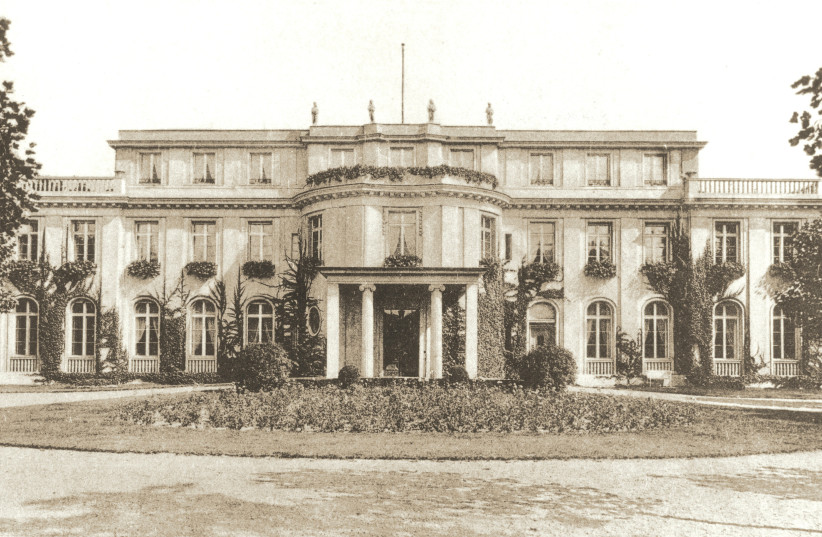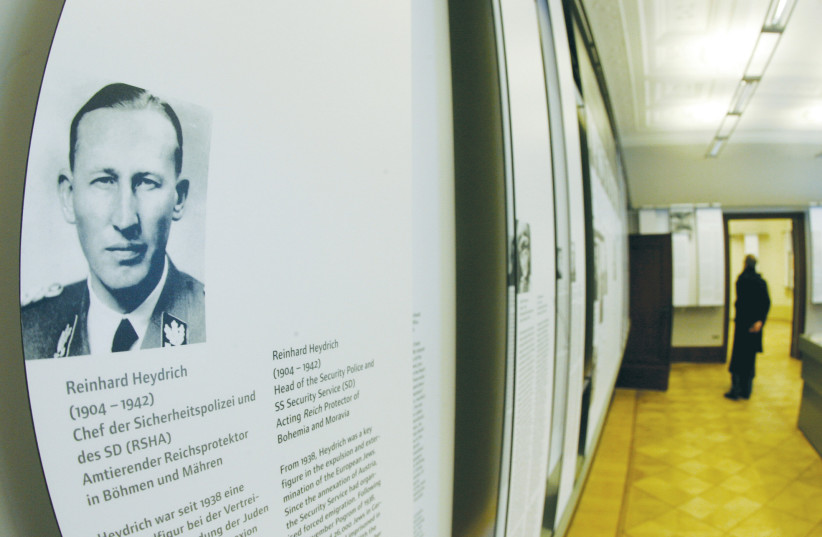 Wannsee Conference: The most shameful document of modern history – opinion
Wannsee Conference: The most shameful document of modern history – opinion
SARA J. BLOOMFIELD
The Wannsee Conference of January 20, 1942, was not about consumer trends, projected profits or shareholder value, it was about life and death. Specifically, systematic death.
.

The CEO of a major corporation once told me he had visited several Holocaust memorials, but most troubling was a site that resonated with his own life. It involved a group of leaders meeting around a conference table to solve a problem and coordinate the solutions required to achieve their goals.
But the Wannsee Conference of January 20, 1942, was not about consumer trends, projected profits or shareholder value, it was about life and death. Specifically, systematic death: The bureaucratically organized annihilation of European Jewry. The meeting minutes, marked top secret, describe the scope of the problem: A list of 34 European countries with estimates of their Jewish populations totaling over 11 million. The CEO could identify with the business-like approach but could not reconcile that with the monstrous purpose: to plan genocide on a continental scale.
The minutes of that meeting, which took place 80 years ago today, are part of the massive documentation that survived, despite German efforts to destroy the evidence of their crimes. In postwar trials, American prosecutors called these minutes perhaps the most shameful document of modern history.
Although the idea of calmly discussing mass murder at a conference is chilling, what happened before and after are equally important to recognizing the warning signs of mass atrocities and genocide. As noted scholar Mark Roseman points out in The Wannsee Conference and the Final Solution: A Reconsideration, the path from social and economic isolation, and forced emigration of Germany’s Jews to the extermination of Europe’s Jews was a twisted one. There were many warning signs, but no one single straight line from Hitler’s 1925 Mein Kampf, filled with hateful diatribes against Jews, to his 1933 rise to power, to the 1935 Nuremberg (citizenship) Laws, to the 1938 nationwide attacks on Jews (Kristallnacht), and to the wartime mass murders that began in 1939 and escalated in 1941 to the most radical step of all, systematic genocide, resulting in the murder of six million Jews.
Along the way, there was an antisemitic, ethno-nationalist ideology underpinning the Nazi state that was relentlessly promoted by massive propaganda, a complete stranglehold on German Jews’ participation in society, unimpeded German expansion into neighboring lands, military conquest and brutal occupation. These factors help explain the interplay of ideas, events and decisions over those 18 years, but there were critical developments well before 1925.

The ideas and political currents that shaped Nazism first emerged in the late 19th century within a Europe undergoing enormous economic and social changes. Industrialization, urbanization and the growth of science and technology served as both constructive and disruptive forces. Darwinian and Marxist ideas were part of an increasing secularization. The rise in education and mass communications enabled the growth of mass political parties and movements.
Popular grievances are always in search of solutions – and scapegoats. Jews had always been used as scapegoats, subjected to persecution for centuries in Christian Europe. But modern times called for modern Judeophobia. The late 19th century saw the rise of ethno-nationalism and eugenics, which led to a toxic brew of scientific racism and new questions: What is our national identity? Who belongs to our nation? Who is worthy of our protection?
Amid two upheavals – World War I, which ended with the collapse of four empires, the creation of new nations, and the Russian Revolution – these questions resonated more powerfully. New ideas for organizing societies emerged: Socialism, communism, fascism, and ethno-nationalism linked to racial antisemitism. Democracy, liberalism, and capitalism were challenged from all sides. As Germany suffered a humiliating defeat, the Weimar Republic was born in 1918. Germany, unified as a country for only 47 years, suddenly became a democracy. Yet, most of the civil service, military and big business did not support it. While many Germans cautiously embraced democracy, others gravitated to the far Right and far Left.
The 1923 coup attempt by a fringe Nazi Party was only one event in a critical year that included threats of a communist coup and crippling inflation. Although these and other crises stabilized somewhat in the latter half of the 1920s, resentments simmered. The 1929 Great Depression put them into sharper focus: Who was the internal enemy that caused our defeat in World War I and created the hated Weimar Republic? Who was behind the communist revolution in Russia? Who controls global capitalism and our livelihoods? What does it mean to be German?
Skillfully weaving a tapestry of late 19th century ideas and early 20th century events, the Nazis offered answers and promised pride, unity, hope and renewal. They would create a racial utopia for pure Germans while removing their racial enemies, the Jews, who posed what they considered an existential threat, and whom they linked to both plutocratic capitalism and communism.
German elites did not necessarily agree with all these answers, which many found extreme, but they believed they could use Hitler to achieve their shared goals of destroying democracy, crushing organized labor, fighting communism and restoring Germany as a great power. They brought him into power believing they had hired him to do their bidding. Although Hitler quickly ended democracy, they had grossly underestimated him: Within his first months, he co-opted military and business leaders, and put Germany on a path to its imperialistic destiny as a racially pure nation that would dominate Europe.
The idea of annihilating European Jewry was not Nazi policy in the 1930s. Then, the goal was the complete isolation and deprivation of Jews, hoping they would emigrate. Although Kristallnacht was an alarming sign of intensifying persecution, it was after German military conquests that Nazi policy evolved toward systematic mass murder. Following the June 22, 1941, German invasion of the Soviet Union, the SS and police, helped by local collaborators, began mass shootings of Jewish men and, a month later, women and children as well. As knowledge of the shootings spread to Nazi officials in Germany and across occupied Europe, “their perception of what was possible also began to change,” notes Rosen. “A psychological threshold was irrevocably crossed.”
The precise date Hitler authorized Nazi leaders to plan the annihilation of Europe’s Jews is not known. What is known is that the purpose of the Wannsee Conference was not to make a decision about what had long been called the final solution of the Jewish question, but to coordinate how it would be done. The conference, called by the deputy of SS leader Heinrich Himmler, aimed to secure the support needed to implement the Final Solution. Participants were from the ministry of Justice, the Four Year Plan (economy), the Interior, Propaganda, and the Foreign Office; others represented the Nazi Party and SS agencies, and focused on racial matters. Almost half the participants held a PhD or an advanced law degree.
As Roseman writes, “Here, in the refined atmosphere of an elegant villa, in a cultivated suburb, in one of Europe’s most sophisticated capitals, fifteen educated, civilized bureaucrats from an educated, civilized society sat about, observing all due decorum. And here they gave the nod to genocide.”
As I discussed with the CEO, the critical point is not just that the Wannsee Conference happened, but what led up to it. When and how could things have been different? In hindsight, there were warning signs along the way. Back at the beginnings of the twisted path, who could have imagined where it would lead? We live in a post-Holocaust world that should have learned the unthinkable is possible. By the time those officials met in their mundane, business-like way, it was too late.
The writer is director of the United States Holocaust Memorial Museum.
Zawartość publikowanych artykułów i materiałów nie reprezentuje poglądów ani opinii Reunion’68,
ani też webmastera Blogu Reunion’68, chyba ze jest to wyraźnie zaznaczone.
Twoje uwagi, linki, własne artykuły lub wiadomości prześlij na adres:
webmaster@reunion68.com
